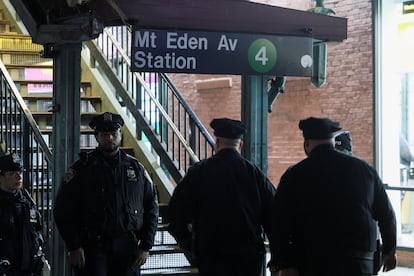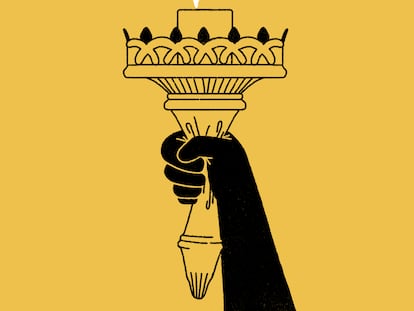New York City to deploy the National Guard on subways after a series of shootings
Commuters may be subjected to random searches of their bags and backpacks, a move a leading civil rights group warns against


A series of violent incidents on the New York subway, the world’s largest network of tunnels and stations, has prompted the state’s governor, Democrat Kathy Hochul, to approve the deployment of 750 National Guard agents in the city’s subway system. Concern among the authorities and the public is contradicted by the subway user’s daily experience of an efficient and generally safe means of transport at any time of the day. Once again, that has been called into question due to a series of widely publicized shootings.
Hochul will send 1,000 officers to the subway: the 750 National Guard officers along with 250 personnel from state transit police forces and the Metropolitan Transportation Authority, she announced Wednesday. The officers will conduct random checks of passengers’ bags and plans are underway to install more security cameras, the governor said. The practice of a random search of bags and backpacks by agents has made many New Yorkers uncomfortable, judging by reactions on social media. Organizations like the American Civil Liberties Union (ACLU), the country’s largest civil rights group, have long warned that the measure is illegal without a search warrant.
“In New York City, police are required by law to let you know when they’re asking for your consent to a search and to let you know that you have the right to say no. If you do consent to a search, it can affect your rights later in court. If the police say they have a search warrant, ask to see it. If they don’t, say ‘I do not consent to this search.’ Police cannot arrest or ticket you simply for refusing to consent to a search,” the New York ACLU explains on its site.
The current round of tightening security measures comes after several shootings in January and February shocked subway riders. Two months ago, a man was fatally shot on a Brooklyn 3 train after attempting to quell a dispute over loud music being played by a commuter (large stereos without headphones are not uncommon on subways, in the streets and in parks). Another man was shot dead on the Bronx 4 train on February 12, when an argument between two groups of teenagers turned violent. The victim was a Mexican immigrant who had not been involved in the fight and worked constantly to send remittances home. In addition, a man was killed in a dispute with other passengers on a Bronx D train on the morning of February 23.
Banning access to violent convicts
“Anyone looking to do harm or spread fear on our subways, you will be caught, plain and simple,” the state governor declared. “There will be consequences. This has to end. New Yorkers deserve no less. To those who are feeling anxious whenever they walk through those turnstiles, we will stop at nothing to keep you safe, you and your family members, and restore your peace of mind.”
On X (formerly Twitter), Hochul specified some of her plans to improve security on the subway: “We will increase security personnel, introduce laws to protect riders and workers, add security cameras, boost collaboration to hold criminals accountable, and expand SCOUT [Street Conditions Observation Unit Team] teams.” The allusion to workers’ safety refers to the assault of a subway conductor, who was attacked in the neck by a passenger, two weeks ago without facing any consequences. The episode led his fellow conductors to strike in protest of the risk posed by their work.
“Within weeks,” Hochul intends to amend legislation to allow the courts to ban those convicted of violent crimes from using the public transport system. She will also allocate an additional $20 million to increase the staffing of mental health teams working in the subway to remove those suffering from mental health problems from the system and take them to specialized centers — even against their will. This issue is a reality evident everywhere from lobbies to platforms to cars. The previous reinforcement of uniformed officers at stations contributed to a 17% reduction in the crimes committed on the subway in February, demonstrating the system’s acceptable level of security, except for incidents that grab the spotlight and garner headlines.
The debate about the New York City subway’s safety — or lack thereof — is a recurring theme. After a series of tragic events involving homeless people with serious mental problems — a dramatic reality on New York streets — Mayor Eric Adams (D) adopted a series of effective measures to guarantee peace on the subway (the only possible home for many homeless people).
In his fight against common crime, the mayor’s most newsworthy initiatives were the new joint police-social services patrols to deal with the most serious cases, and a friendly robot to patrol Times Square station. Initially accompanied by a couple of officers as tutors, the autonomous robot Knightscope K5, or AK5, was withdrawn from circulation a month ago after it was found that it could not go up and down stairs, as had been warned previously. The mayor once compared the machine to a Roomba vacuum. Civil liberties advocates and police reform activists have questioned the need for this and other high-tech devices, such as the police robot dog Digidog, another of Adams’ big initiatives, for possible data capture.
Sign up for our weekly newsletter to get more English-language news coverage from EL PAÍS USA Edition
Tu suscripción se está usando en otro dispositivo
¿Quieres añadir otro usuario a tu suscripción?
Si continúas leyendo en este dispositivo, no se podrá leer en el otro.
FlechaTu suscripción se está usando en otro dispositivo y solo puedes acceder a EL PAÍS desde un dispositivo a la vez.
Si quieres compartir tu cuenta, cambia tu suscripción a la modalidad Premium, así podrás añadir otro usuario. Cada uno accederá con su propia cuenta de email, lo que os permitirá personalizar vuestra experiencia en EL PAÍS.
¿Tienes una suscripción de empresa? Accede aquí para contratar más cuentas.
En el caso de no saber quién está usando tu cuenta, te recomendamos cambiar tu contraseña aquí.
Si decides continuar compartiendo tu cuenta, este mensaje se mostrará en tu dispositivo y en el de la otra persona que está usando tu cuenta de forma indefinida, afectando a tu experiencia de lectura. Puedes consultar aquí los términos y condiciones de la suscripción digital.
More information
Archived In
Últimas noticias
ChatGPT fails the test: This is how it endangers the lives of minors
The late consecration of women artists in their 90s
The Florida Keys tourist paradise is besieged by immigration agents: ‘We’ve never seen anything like this’
The latest scam on WhatsApp behind the legal dream: using immigration status as bait
Most viewed
- Families demand repatriation of bodies of Colombians who died in Ukraine: ‘This war is a slaughterhouse for foreigners’
- The low-cost creative revolution: How technology is making art accessible to everyone
- Liset Menéndez de la Prida, neuroscientist: ‘It’s not normal to constantly seek pleasure; it’s important to be bored, to be calm’
- Christian Louboutin: ‘Young people don’t want to be like their parents. And if their parents wear sneakers, they’re going to look for something else’
- ‘El Limones’ and the growing union disguise of Mexican organized crime









































